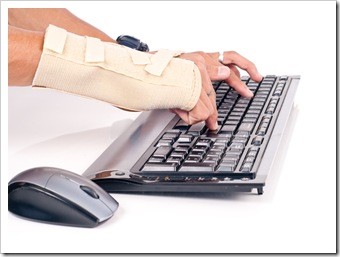Today’s research demonstrates significant improvement in Carpal Tunnel Syndrome with Chiropractic care. Find out how you and your family can benefit from Chiropractic. Call – 406-656-7000.
At Van Chiropractic our purpose is to check, educate, and adjust as many families as possible toward optimal health through natural chiropractic care. Dr. Grey Gardner commits several hours every week to reviewing the most recent research to ensure that Van Chiropractic always provides the highest standards of care. Here you will find research on Carpal Tunnel Syndrome. Should you have any questions or concerns please feel free to contact our office.
“The doctor of the future will give no medicine but will interest his patients in the care of the human frame, in diet and in the cause and prevention of disease.” –Thomas Edison
Carpal Tunnel Syndrome can affect everyone

Today just about everyone can be affected, but particularly people involved in occupations or leisure activities that require repetitive use of the hands and wrists (i.e., office, skilled labor jobs, tennis, golf or even knitting). Medical doctors commonly prescribe anti-inflammatory drugs, which prove ineffective in most patients and cause adverse side effects in others.
The double crush syndrome is a compression neuropathy characterized by affecting two areas along the same nerve, one usually distant from the other. A growing number of researchers have suggested a correlation between some peripheral neuropathies like carpal tunnel syndrome and cervical nerve root compression another. The nerve is “crushed” or irritated in the spine, “priming” the more distal areas of the nerve for dysfunction when that part is stressed by the second “crush”).
Autonomic dysfunction in idiopathic carpal tunnel syndrome Verghese J, Galanopoulou AS, Herskovitz S, Muscle Nerve 2000 Aug;23(8):1209-13
This is the study of 76 patients with CTS (in 139 limbs). Autonomic symptoms were reported in 76 limbs (47 patients). Of these, 59% consisted of swelling of the fingers, 39% dry palms, 33% Raynaud’s phenomenon, and 32% blanching of the hand. Sympathetic skin response (SSR) had a sensitivity/specificity ratio of 34/89% in CTS with autonomic symptoms. The presence of autonomic disturbances was significantly associated with female gender but not age, duration of disease, or clinical severity in a binary logistic regression model.
It appears that autonomic disturbances are common (55%) in CTS, occurring with increasing severity of electrophysiologic findings.
Conservative chiropractic care of cervicobrachialgia Glick DM, Chiropr Res J, 1989; 1(3):49-52
Cervicobrachialgia, also known as “brachial neuritis” or “brachial neuralgia” involves neck and arm pain that can be described as “sharp,” “stabbing,” or “aching,” with acute sudden onset. The pain is in the shoulder blade, the side of the neck and may continue through the upper arm.
This is the case of a 42 year-old woman diagnosed with the above condition who had suffered a fall skiing during the prior week when symptoms began. Upper cervical x-rays revealed the atlas to be displaced laterally to the right and rotated anterior on that side. The patient was adjusted upper cervically by hand.
Immediately following the first adjustment the patient reported noticeable relief in symptoms. 48 hours later she received a second adjustment. Three days later she was checked again and did not need an adjustment.
Comparative efficacy of conservative medical and chiropractic treatments for carpal tunnel syndrome: a randomized clinical trial. Davis PT, Hulbert JR, Kassak KM, et al. Journal of Manipulative and Physiological Therapeutics, June 1998, vol.21/no.5, pp317-26.
This study showed that chiropractic was as effective as medical treatment in reducing symptoms of CTS. Chiropractic care included spinal adjustments, and in addition, ultrasound over the carpal tunnel and the use of nighttime wrist supports.
Clinical commentary: pathogenesis of cumulative trauma disorders. MacKinnon S. Journal of Hand Surgery, Sept. 1994, 873-883.
In a study of 64 patients with repetitive stress disorders of whom 34 had wrist surgery, wrist pain or discomfort was not the only symptom the patients complained of.
Most patients had multiple problems, especially muscle imbalance. The high failure rate of surgery causes the author to rethink the cause of CTS: “Unnatural postures for extended periods creating pressure on the nerves in the neck, leading to neurological and other symptoms…even when extremity surgery improves the peripheral symptoms such as numbness in the hands, other associated problems like neck stiffness and shoulder pain persist.”
The double crush in nerve entrapment syndromes. Upton, ARM, McComas AJ. Lancet 2:329, 1973.
67% to 75% of patients who had carpal tunnel syndrome or ulnar neuropathy also had spine nerve root irritation.
Impaired axoplasmic transport and the double crush syndrome: food for chiropractic thought. Czaplak S, Clinical Chiropractic Jan. 1993 p.8-9.
The author writes: “Chiropractic has an extensive anecdotal history of patients being relieved of classic carpal tunnel symptoms with spinal adjustments and/or cervical tractioning only.”
Carpal tunnel syndrome as an expression of muscular dysfunction in the neck. Skubick DL, Clasby R, Donaldson CCS et al. J Occup Rehabil 3:31-44, 1993.
In this study of 18 patients it was concluded that carpal tunnel syndrome can occur from increased forearm flexor activity caused by muscle dysfunction in the neck.
Double crush syndrome: what is the evidence? Swenson RS. J Neuromusculoskeletal System, Spring 1993; 1(1): 23-29.
The authors hypothesize that a nerve injury close to the spine may weaken peripheral nerves.
Surgery of the peripheral nerve. MacKinnon SE, Dellon AL. Thieme Medical Publishers. New York, 1988.
Nerve compression near the spine is found in people with carpal tunnel syndrome.
Double crush syndrome: cervical radiculopathy and carpal tunnel syndrome. Osterman AL, Pfeffer G, Chu J, et al. Presented at the 41st annual American Society for Surgery of the Hand, New Orleans, LA 1986.
Describes the double crush syndrome in detail.
The double lesion neuropathy: an experimental study and clinical cases. Nemoto et al Abstract 123, Second Int’l Congress. Boston, MA Oct. 1983.
Cervical nerve compression can block the distribution of necessary cellular material to the distal nerve axon such as in the wrist, making it more susceptible to injury.
The relationship of the double crush syndrome (an analysis of 1,000 cases of carpal tunnel syndrome). Hurst LC, Weissberg D, Carroll RE. J Hand Surg 10B: 202, 1985.
A significant correlation was found between bilateral carpal tunnel syndrome and radiologically diagnosed cervical arthritis.
Double crush syndrome: a chiropractic/surgical approach to treatment. Cramer SR, Cramer LM Dig of Chiropractic Economics Mar/April, 1991.
Seventy five patients received chiropractic and hand surgery/rehabilitation. It was concluded that these two approaches are complementary and can be effective in improving the lives and prognoses of patients.
Carpal tunnel syndrome: a case report. Ferezy, JS, Norlin, WT. Chiropractic Technique, Jan/Feb 1989 P.19-22.
Electromyelography demonstrated objective improvement in this case of CTS following chiropractic care.
Research finds surface EMG useful in treatment of CTS. Prosanti MP. Advances For Physical Therapists, July 6, 1992.
Muscles of the neck could be involved in problems within the arm and wrist and has been a subject of discussion for several years.
A treatment for carpal tunnel syndrome: evaluation of objective and subjective measures. Bonebrake AR, Fernandez JE, Marley RJ et al. Journal of Manipulative and Physiological Therapeutics, Vol.13 No.9 Nov/Dec 1990.
Thirty-eight CTS sufferers underwent spinal manipulation and extremity adjusting, soft tissue manipulation, dietary changes and daily exercises. Post treatment results showed improvement in all strength and range of motion measures. A significant reduction of nearly 15% in pain and distress ratings was documented.
Resolution of a double-crush syndrome. Flatt DW. Journal of Manipulative and Physiological Therapeutics, July/August 1994; 17(6): 395-397.
A 63-year-old man suffered from a 36-month history of right anterior leg numbness and recurrent lower back pain. Complete resolution of right anterior leg numbness followed chiropractic. Although not a carpal tunnel problem, the double crush phenomenon, in this case involving the leg, and its resolution under chiropractic care is of interest.
Spinal Manipulation, 5th edition by Bourdillon JE, Day EA, Bookhout MR: Oxford, England, Butterworth-Heinemann Ltd, 1992:
“Faulty innervation caused by spinal joint lesions is one of the main factors in the production of carpal tunnel syndrome.” p. 207.
Double crush syndrome: chiropractic care of an entrapment neuropathy. Mariano KA; McDougle MA; Tanksley GW. Journal of Manipulative and Physiological Therapeutics,1991 May, 14(4): 262-5.
Discusses the relationship between double crush syndrome and chiropractic care.
